 The wedding ceremony has always been distinguished by its special splendor and observance of many folk traditions. Preparations for this event began long before the wedding itself. On the wedding day, the bride was dressed for the wedding by her friends and matchmakers. The ritual of dressing the bride took place in the pantry, and was accompanied by ritual actions and songs that were composed especially for this event. Wedding clothes for the newlyweds were sewn before the wedding. Embroidered shirts, which had to be completely new, had a special meaning in the outfit. Wedding clothes were kept and revered by the married couple throughout their life together.
The wedding ceremony has always been distinguished by its special splendor and observance of many folk traditions. Preparations for this event began long before the wedding itself. On the wedding day, the bride was dressed for the wedding by her friends and matchmakers. The ritual of dressing the bride took place in the pantry, and was accompanied by ritual actions and songs that were composed especially for this event. Wedding clothes for the newlyweds were sewn before the wedding. Embroidered shirts, which had to be completely new, had a special meaning in the outfit. Wedding clothes were kept and revered by the married couple throughout their life together.
The most important event of the wedding was the wedding of the young in the church. This is the most solemn, exciting and decisive ceremony, which united the young into one family. The order of arrival at the church for the wedding differed in different localities. Somewhere it was customary for the bride and groom to come or come to the church separately, with their relatives. And somewhere the groom first came to the bride, so that they could go to church together. From the church, everyone usually went together to the place of celebration, but in some areas, the young people dispersed to their homes after the wedding, and only then the groom, having gathered his wedding retinue, went to pick up the bride.
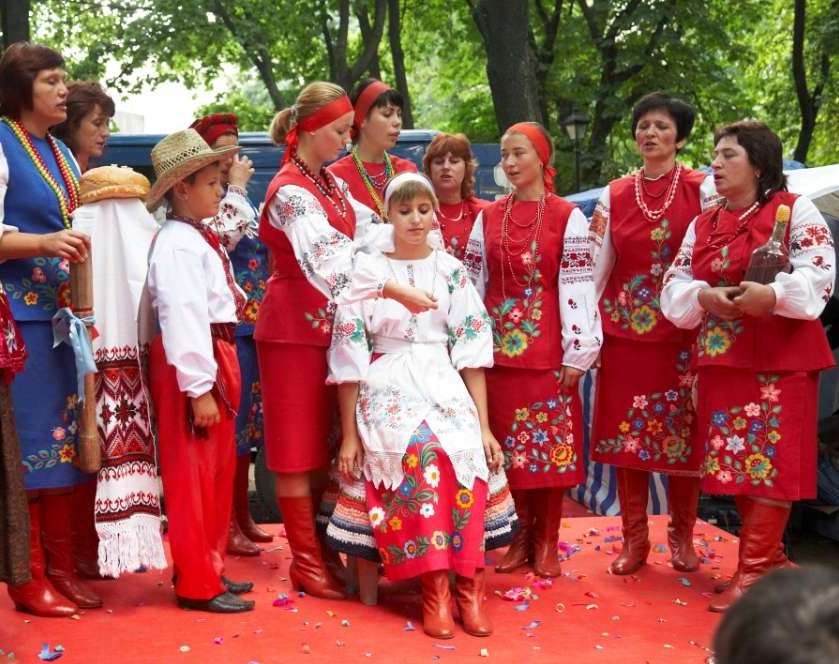 The groom's wedding train consisted of an odd number of relatives and guests, because the bride would have to match the groom. Boyars (friends, elders) - friends of the groom, stood out among the other guests with tied towels. Matchmakers held wedding bread in their hands - a loaf, a kalach, a cone, and carried gifts tied in scarves to the bride and her relatives. Girls from the groom's family were called svitylki. They also carried ritual bread - a twig, a saber, a sword. Before the wedding train set off, the groom's mother blessed him. Having said farewell words, she showered him with coins, rye grains and sweets. In the Chernihiv region, mothers put a fur coat turned inside out on their groomsmen and sprinkled them with oats, after which the groom and his friend walked around the tub in which the bread was kneaded.
The groom's wedding train consisted of an odd number of relatives and guests, because the bride would have to match the groom. Boyars (friends, elders) - friends of the groom, stood out among the other guests with tied towels. Matchmakers held wedding bread in their hands - a loaf, a kalach, a cone, and carried gifts tied in scarves to the bride and her relatives. Girls from the groom's family were called svitylki. They also carried ritual bread - a twig, a saber, a sword. Before the wedding train set off, the groom's mother blessed him. Having said farewell words, she showered him with coins, rye grains and sweets. In the Chernihiv region, mothers put a fur coat turned inside out on their groomsmen and sprinkled them with oats, after which the groom and his friend walked around the tub in which the bread was kneaded.
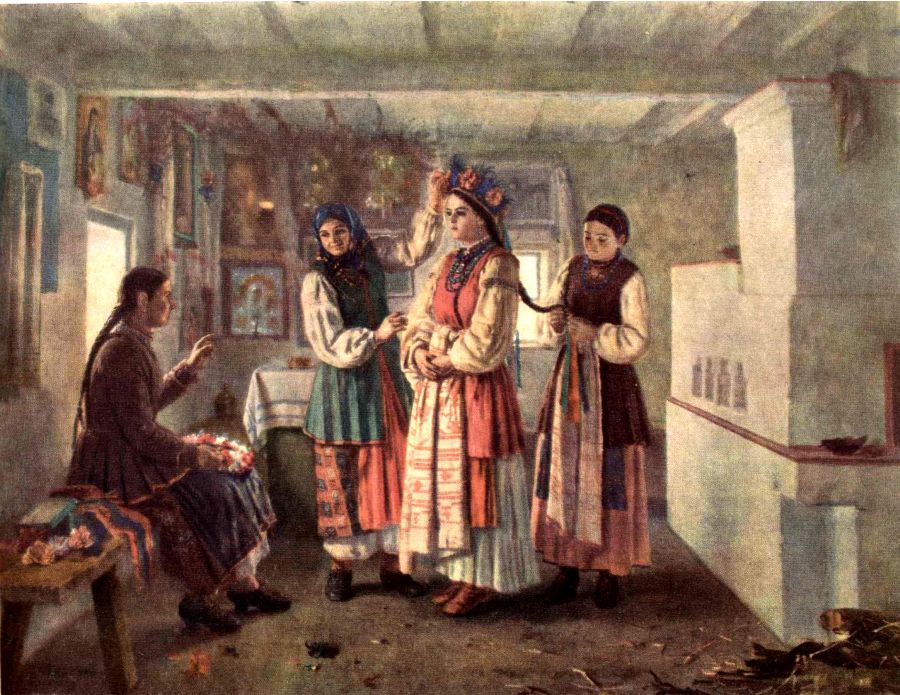 In most of Ukraine, it was customary for the newlyweds and guests present at the wedding to go to the bride's parents' house after the wedding. The parents met the newlyweds at the threshold. The bride and groom bowed to them three times, and the bride's mother and father blessed the newlyweds with an icon and bread and salt. In some regions, there was a tradition of serving honey with a loaf of bread after the blessing. This was done both when escorting the newlyweds to church for the wedding and when meeting the newlyweds who had already been married.
In most of Ukraine, it was customary for the newlyweds and guests present at the wedding to go to the bride's parents' house after the wedding. The parents met the newlyweds at the threshold. The bride and groom bowed to them three times, and the bride's mother and father blessed the newlyweds with an icon and bread and salt. In some regions, there was a tradition of serving honey with a loaf of bread after the blessing. This was done both when escorting the newlyweds to church for the wedding and when meeting the newlyweds who had already been married.
In several regions of Ukraine in the 19th century, the custom spread for the young man and his wife to return from the church separately after the wedding, each to their own home. A feast was arranged in the bride’s house for the young people, who were having fun while waiting for the groom. The groom gathered a wedding train of his relatives and friends and set off for the bride. When he approached the bride’s courtyard, the groom was awaited by an “interception” arranged by the bride’s young relatives. They demanded a ransom from the groom’s procession for their relative.
 At the gate of the bride's house, the boys stopped the groom's retinue, demanding a "gatekeeper's" ransom. They were given money or brought a glass, after which the wedding train could pass into the yard. At the threshold of the groom's house, the next obstacle was waiting for the bride's friends. They paid for the bride with kalachi and sweets. Then the groom had to buy a place next to his bride, which was occupied by her unmarried brother. The role of the brother could be played by any teenage boy from the family or neighbors. Having paid the ransom to the brother, the groom took the vacated place next to his bride. Now the guests could also sit at the tables. During the wedding feast, the young people were taken "to the post", where a fur coat was laid out for them with the wool facing up (this symbolizes a rich life), and rye grains and money were poured under the fur coat.
At the gate of the bride's house, the boys stopped the groom's retinue, demanding a "gatekeeper's" ransom. They were given money or brought a glass, after which the wedding train could pass into the yard. At the threshold of the groom's house, the next obstacle was waiting for the bride's friends. They paid for the bride with kalachi and sweets. Then the groom had to buy a place next to his bride, which was occupied by her unmarried brother. The role of the brother could be played by any teenage boy from the family or neighbors. Having paid the ransom to the brother, the groom took the vacated place next to his bride. Now the guests could also sit at the tables. During the wedding feast, the young people were taken "to the post", where a fur coat was laid out for them with the wool facing up (this symbolizes a rich life), and rye grains and money were poured under the fur coat.
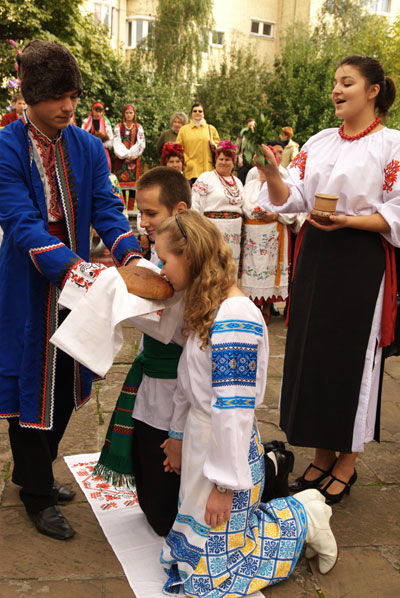 After the groom sat down on the purchased seat, the bride's relatives presented gifts to the bride's relatives. Then the bride's relatives presented their new relatives with appropriate gifts. Although in some regions, only the groom's relatives presented the bride's relatives with gifts, without appropriate gifts. The young man presented his mother-in-law with beautiful leather boots, the young wife's sisters received colorful scarves, and her girlfriends with colorful ribbons. The crowning recognition and approval of the new family from all relatives and guests was the treat of a wedding loaf. A piece of the loaf was first served to the parents, then to the newlyweds, after which the loaf was divided among all the guests, leaving only the "sole" of the loaf for distribution to the "Cossacks" - those who did not get to the festive table, but remained outside the threshold of the house, in the yard or near the windows.
After the groom sat down on the purchased seat, the bride's relatives presented gifts to the bride's relatives. Then the bride's relatives presented their new relatives with appropriate gifts. Although in some regions, only the groom's relatives presented the bride's relatives with gifts, without appropriate gifts. The young man presented his mother-in-law with beautiful leather boots, the young wife's sisters received colorful scarves, and her girlfriends with colorful ribbons. The crowning recognition and approval of the new family from all relatives and guests was the treat of a wedding loaf. A piece of the loaf was first served to the parents, then to the newlyweds, after which the loaf was divided among all the guests, leaving only the "sole" of the loaf for distribution to the "Cossacks" - those who did not get to the festive table, but remained outside the threshold of the house, in the yard or near the windows.
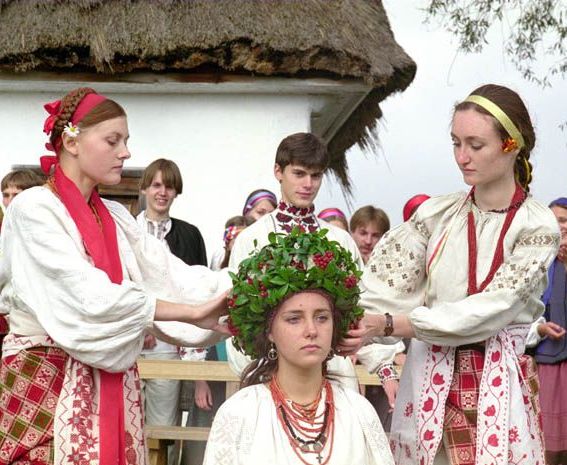 Next came the ritual of "covering" the young wife. The matchmakers removed the bride's wedding wreath and put a married woman's cap on her head or tied a scarf. This ritual symbolized the bride's farewell to her maidenhood and transition to womanhood. The whole action was accompanied by mournful songs sung in chorus by the women present. This marked the end of the girl's life in her parents' house. Now she was sent to her husband's house. Farewell to her parents, relatives, and home was very dramatic, accompanied by tears and sad songs. The dowry in chests, pillows, and feather beds were carried out and placed on the carts of the wedding train. The wedding procession went to the young man's house, where the newlyweds were met by his parents with an icon and a loaf of bread for blessing.
Next came the ritual of "covering" the young wife. The matchmakers removed the bride's wedding wreath and put a married woman's cap on her head or tied a scarf. This ritual symbolized the bride's farewell to her maidenhood and transition to womanhood. The whole action was accompanied by mournful songs sung in chorus by the women present. This marked the end of the girl's life in her parents' house. Now she was sent to her husband's house. Farewell to her parents, relatives, and home was very dramatic, accompanied by tears and sad songs. The dowry in chests, pillows, and feather beds were carried out and placed on the carts of the wedding train. The wedding procession went to the young man's house, where the newlyweds were met by his parents with an icon and a loaf of bread for blessing.
There were customs for the entry of a young wife into her husband's house. To prevent trouble in the new family, the young wife would cross the fire or enter the house along a path made of white cloth, which was laid from the threshold to the table. In her hands, the daughter-in-law held a black chicken that she brought from her parents' house. Upon entering the house, she would throw the chicken under the stove, asserting herself as an equal mistress in her husband's house. The newlyweds were welcomed, treated, and then sent to the marriage bed, which was equipped in a pantry or other separate room. Guests and relatives continued to feast and sing cheerful songs until nightfall. In most Ukrainian regions, it was customary to hang a sheet from the newlyweds' bed for public viewing to prove the daughter-in-law's premarital innocence. If the young wife was chaste before the wedding, then upon becoming a woman, she would bring prosperity to the family and increase well-being.
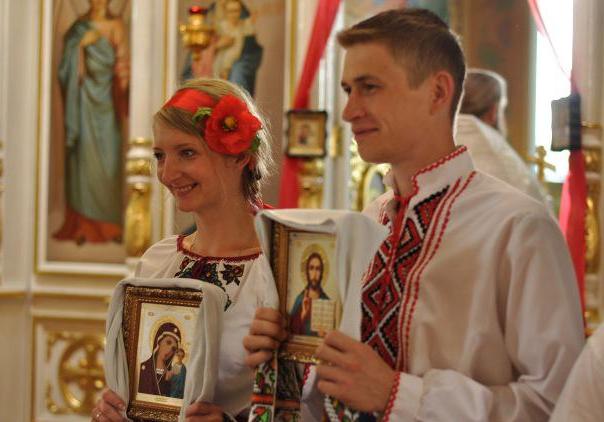 On the second wedding day, only married couples gathered at the newlyweds' house to continue the festive feast. The young people were not invited on this day. In Podillia and Kyiv region, it was customary to bring breakfast to the young wife. In the Carpathians, there was a custom for the young to go to "mitvins", that is, to wash themselves, to a mountain river in the morning. In central Ukraine, on the second wedding day, the ritual of "beating porridge" was performed. The wedding porridge was cooked in a new pot, then the pot was broken, those who wanted it were treated, and the rest was poured into the young wife's apron, symbolizing the wish for fertility for the woman. She went to the yard, garden, vegetable garden and poured porridge from the apron there, wishing the entire household multiplication. The guests, continuing the fun, arranged a wedding procession through the village. They dressed up as gypsies, sang cheerful wedding songs, joked, and collected treats from neighbors. A typical Ukrainian wedding ritual was riding in a cart around the village of the parents of the bride and groom, swinging them in rows, and swimming in the river.
On the second wedding day, only married couples gathered at the newlyweds' house to continue the festive feast. The young people were not invited on this day. In Podillia and Kyiv region, it was customary to bring breakfast to the young wife. In the Carpathians, there was a custom for the young to go to "mitvins", that is, to wash themselves, to a mountain river in the morning. In central Ukraine, on the second wedding day, the ritual of "beating porridge" was performed. The wedding porridge was cooked in a new pot, then the pot was broken, those who wanted it were treated, and the rest was poured into the young wife's apron, symbolizing the wish for fertility for the woman. She went to the yard, garden, vegetable garden and poured porridge from the apron there, wishing the entire household multiplication. The guests, continuing the fun, arranged a wedding procession through the village. They dressed up as gypsies, sang cheerful wedding songs, joked, and collected treats from neighbors. A typical Ukrainian wedding ritual was riding in a cart around the village of the parents of the bride and groom, swinging them in rows, and swimming in the river.
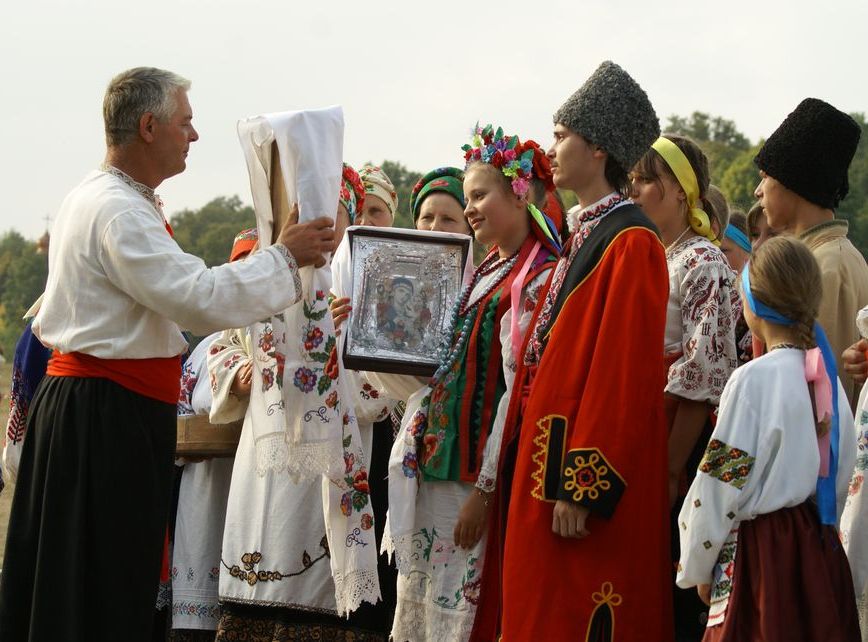
After the first month of living together, the final wedding ceremony was held, which had different names. In the Hutsul region it was called Kalachiny, in the Lviv region - Dyaka or Chesto, in the Volyn and Khmelnytsky regions - Khliba, and in other areas - Expensive Borscht. The young man invited his parents and wife, as well as other relatives, to a rich feast in honor of the prosperity of his family and household. This feast, like all Ukrainian folk holidays, was decorated with melodious songs, lively dances and cheerful good jokes.

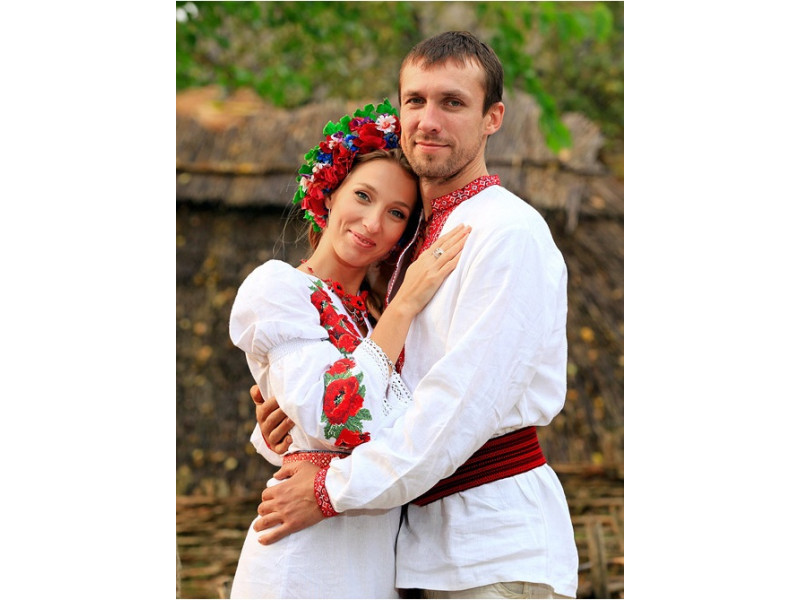
Write a comment